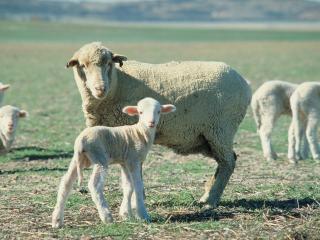There are several benefits to both the ewe and its progeny by weaning 12 to 16 weeks after the start of lambing, according to research by the Department of Primary Industries and Regional Development.
With more than 70 per cent of the State’s ewe flock having lambs at the hoof, the department has reminded producers the timing of weaning is important to improve ewe and lamb survival rates over summer and autumn.
April born lambs should be weaned by 16 weeks after the start of lambing, while flocks with August born lambs should be weaned by 12 weeks after the start of lambing.
Veterinary officer Danny Roberts said weaning at this age helped lambs to optimise worm control, growth rates and pasture use.
“The ultimate aim is to capture as much live weight gain before pasture senescence to improve survival,” Dr Roberts said.
“Weaning at this time allows lambs to graze clover dominated pastures to ensure maximum growth rates.
“Merino lambs should attain 45 per cent of the mature ewe’s live weight when pastures hay-off but the live weight target will vary, depending on the mature ewe’s frame size.
“To achieve this target, 85 per cent of the potential maximum lamb growth for the year needs to occur before the end of October.
“The best time to wean will be more challenging in areas that have received below average rainfall, as lambs will be lighter.”
Producers also benefit from greater flock management flexibility after weaning; enabling ewes to improve their condition, graze grass dominate paddocks, sold or agisted.
Dr Roberts said weaning by 12-16 weeks after the start of lambing minimised the risk of high worm burdens in lambs, which can lead to scouring, fly strike and reduced growth rates.
“Lambs have no immunity to worms so weaning removes lambs from paddocks that have the potential to become contaminated with worms via their mothers,” he said.
“Ideally, lambs should be weaned onto paddocks with a lower worm burden, aided by an effective drench.”
Ewes also benefit from weaning, as they have more time to regain condition before joining.
“Ewes need sufficient time and feed on offer (FOO) to regain condition, as they need to be greater than condition score 3 by joining to achieve good reproductive rates,” Dr Roberts said.
The department recommends lambs be weaned into paddocks with access to good quality water and FOO levels of more than 1500 kilograms per hectare, to maximise their intake energy.
Dr Roberts said to optimise weaner survival in summer and autumn, it was best to aim for a minimum live weight of 20kg and condition score 2 before pasture hay-off.
“Producers with April born lambs may need to feed a lupin or lamb pellet supplement, if FOO is lower than 1500kg/ha in July,” he said.
“One solution is to use creep feeders from the start of lambing, lamb marking eight weeks after the start of lambing and then weaning, when the lick feeder goes with the weaned lambs.
“It’s important to remember that lambs require supplementary feeding training, introducing lupins or pellets, while they are still with their mothers.”
At weaning it is important to provide a second vaccination for clostridial diseases and cheesy gland.
More sheep best practice weaning information is available on the department’s website along with details about its recently updated Condition Scoring app.
The department’s Season 2019 webpage also has timely livestock management information, as well as useful cropping, weather, finance and wellbeing information.

Media contacts:
Jodie Thomson/Megan Broad, media liaison +61 (0)8 9368 3937
